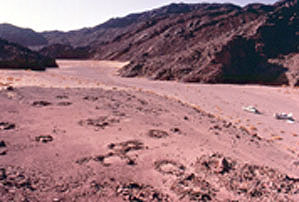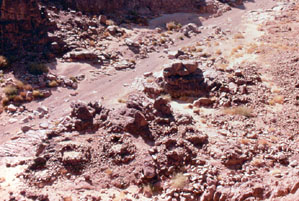|
An overview of the central part of the
main settlement at Bir Gidami,
looking west towards the low end of the wadi:
|
|
East of the main settlement of Bir
Gidami, at the
very end of the wadi, is a small satellite settlement:
|
|
|
|
|

|
|

|
|
|
|
|
|
|
|
|
Objective of visit:
|
|
To draw a measured plan
of the site and study the surface
remains (including the ceramic finds). |
|
Date of visit:
|
|
- June 1999 |
|
Fellow visitors:
|
|
Prof.Dr. Steve Sidebotham
(University of Delaware) and
Prof.Dr. Jim Harrell (University of Toledo). |
| Results: |
|
A survey was performed
using the Global Positioning System,
a theodolite and steel tape measures. Off-site assistance was given by
pottery expert Dr. Roberta Tomber (Museum of London). No excavations
took
place. Our plans and description were published
in: S.E. Sidebotham, H.
Barnard and G. Pyke; Five enigmatic late Roman settlements in the
Eastern Desert; Journal of Egyptian
Archaeology 2002; vol. 88: pp. 187-225. |
| Approximate position and date
of the site: |
|
Bir Gidami is in the
central part of the Egyptian Eastern
desert, just south of the Qena-Safaga asphalt road. Surface pottery
dated
to the late Roman period (ca. 300 - 600 AD). |
| Short description of the site: |
|
Bir Gidami was a large
settlement of simple huts, built
in dead-end wadi far from any ancient roads, mines or quarries. Surface
finds were limited to potsherds and the function of the settlement
remains
enigmatic. |
| Additional remarks: |
|
The main settlement at
Bir Gidami has two satellite settlements,
one to the north and one to the east. The reason for their existence
might
have been the hunting or gathering of yet unknown commodities or the
temporary
residence for political or religious refugees. Our work was sponsored
by
the University of Delaware and private donors. |
| HOME |
|
|
 |
|
|